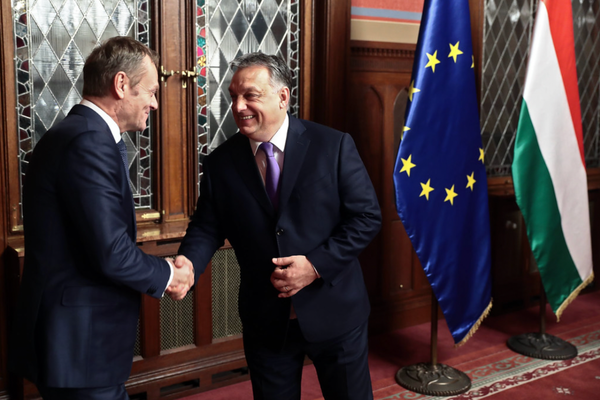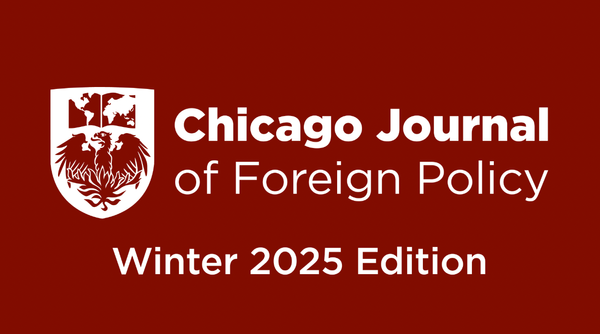Impact of the Nuclear Non-Proliferation Treaty on Arms Control Efforts
By Andrew Gary, University of North Carolina
This article appeared in CJFP's Winter 2024 publication.
Background
Several years prior to the Second World War it had been theorized that through the destruction of civilian cities, air power would be able to win a war on its own. Italian military theorist Giulio Douhet once postulated that by targeting civilians, a state could break enemy morale and force their enemy to sue for peace[1]. However, the strategic bombing efforts on both sides of World War Two proved the contrary, that bombing galvanized civilians against capitulation. However, the destruction of Hiroshima and Nagasaki were exceptional to theorists: the power to instantly destroy cities put civilian thinking more in line with Douhet’s predictions. National governments subsequently concluded that a war that featured nuclear weapons would be unacceptably disastrous. Global efforts were made almost immediately to find ways to control the production and development of nuclear weapons around the world. These efforts would be unsuccessful until the 1960s, when the Treaty on the Non-Proliferation of Nuclear Weapons (NPT) would be negotiated.
Negotiations
The NPT is principally trust-based[2]. Nuclear weapon states (NWS) and non-nuclear weapon states (NNWS) must be comfortable with not knowing if states will comply with the terms of the Treaty. During the cold war, NNWS were put into the position of surrendering their access to the deadliest military technology in history based on the solemn promise of NWS that had shown no reservations about intervening directly in the sovereign affairs of other states. It would be these dilemmas that shaped the entirety of the negotiations surrounding the NPT.
By the 1960s, it had become clear that allowing the nuclear arms race to continue was not a viable long-term strategy for stability. The early 1960s also presented an opening for negotiations that hadn't previously existed. The Sino-soviet split and the Cuban missile crisis made real the fact that nuclear proliferation was not in the best interest of either the US or USSR[3]. In addition, a growing international movement began to more vocally push for international action to regulate nuclear weapons[4]. This confluence of national interests allowed the United Nations to pass "The Irish Resolution" by a unanimous vote[5]. Ireland had long been advocating for international action in the face of the growing nuclear arms race, and it took years of careful diplomacy by Ireland in coordination with other states as well as several nuclear crises to get the world’s superpowers to agree to take legislative action.
Shortly thereafter, the United Nations would form the Eight Nation Committee on Disarmament (ENDC) with the United States and the Soviet Union as co-chairs[6]. The two superpowers would negotiate between themselves for quite some time on what the initial proposal to the ENDC should be. These secret negotiations saw the two nations exchange draft agreements and argue over semantic disagreements so that they could present a fully united front against the demands of non-aligned states[7]. A major point of contention arose over whether a nuclear weapon-sharing program constituted nuclear proliferation. At the time, the United States was considering loaning nuclear weapons to NATO members, and the Soviet Union pushed for this practice to be banned under a potential agreement[8]. Another major issue stemmed from the definition of nuclear controls. The United States wanted to have some system of international oversight of civilian nuclear reactors, mainly through the International Atomic Energy Agency. Opposition to this proposal mainly came from western Europe, which did not want to surrender control over nuclear regulatory standards to an international body[9].
However, demands from NNWS quickly overshadowed these concerns. NNWS demanded a strong commitment to disarmament. Several states, such as the United Arab Republic and India, made it clear that unless the NWS agreed to halt the arms race and began disarming their nuclear weapons, they would not sign on to any agreement and would even consider developing nuclear programs of their own[10].
Another issue that arose during negotiations was the status of regional nuclear agreements. Latin America and the Caribbean had negotiated The Treaty of Tlatelolco, which banned the use and development of nuclear weapons in Latin America and the Caribbea[11]. Several states, such as Mexico, pushed for the NPT to grant international recognition to this agreement and others like it. These negotiations intertwined with another major issue that was being discussed at the time: restrictions on nuclear weapons testing.
The Partial Nuclear Weapons Test Ban Treaty was ratified just a few years before the start of negotiations on the NPT. Some states led by Brazil and India opposed the NPT including a ban on nuclear testing[12]. They principally objected to bans on "peaceful" nuclear explosions. They maintained that the right to detonate nuclear devices should not be limited to NWS alone and that the potential benefits of these explosions should be available to all states[13]. Brazil and India specifically claimed that research and civilian benefits of these explosions should not be taken away from NNWS.
Another major area of negotiation was the peaceful use of nuclear energy. Mexico advocated for language that would have imposed a duty upon states to cooperate on nuclear energy programs[14]. Both NWS and NNWS opposed it, as the implications of a duty to provide nuclear energy resources and expertise would be expensive and risky. The compromise that emerged gave states the right to use nuclear energy for peaceful purposes and encouraged those with the means to do so to cooperate in the peaceful development and application of nuclear energy[15].
The last major area of negotiation was the duration of the treaty. The United States and Soviet Union favored a treaty of unlimited duration under the premise that a nonproliferation agreement’s expiration would only ever restart the arms race it sought to prevent[16]. However, the United Kingdom and several non-aligned states pushed for the treaty to last only twenty-five years with the possibility of extending its duration at a later date. The protocol for extending its duration would be an international conference with the power to propose alterations to the Treaty[17].
Nonproliferation and Nuclear Apartheid
The final treaty produced by the ENDC received instant criticism. The first major category of objection came from states that thought the NPT was too lenient on disarmament. The treaty contained no specific requirements for NWS in terms of eliminating or even reducing their nuclear stockpiles. It instead required that "Each of the Parties to [it]… to pursue negotiations in good faith on effective measures relating to cessation of the nuclear arms race at an early date and to nuclear disarmament, and on a treaty on general and complete disarmament under strict and effective international control.[18]" A provision this vague was indeed disappointing, but it still marked a major milestone in international affairs as the NWS had agreed, at least in principle, to total disarmament.
The second major objection came from states that were not already NWS but were on the way there. They claimed the NPT would create a system of nuclear apartheid[19]. NNWS pointed out that not requiring nuclear disarmament while restricting the vast majority from a powerful military tool would leave them extremely vulnerable. They would have to rely on the word of NWS that nuclear weapons would not be used against them, while NWS could rely on nuclear deterrence for security. Some states, such as India and Pakistan, refused to ratify the NPT on these grounds, and they have since developed their own domestic nuclear capabilities.
Impact on Nuclear Proliferation
It is exceedingly difficult to determine the impact or even the effectiveness of the NPT in achieving its three goals of nonproliferation, disarmament, and the use of peaceful nuclear energy. The NPT was the first of many nuclear agreements that would be negotiated over the course of the Cold War, and the impact of other agreements is much easier to see. The Partial Test Ban Treaty and other agreements largely ended nuclear testing in the ocean and the atmosphere, and while the Comprehensive Test Ban Treaty has yet to enter force, there is a strong norm against nuclear weapons testing. The bilateral arms control and reduction treaties signed by the US and USSR saw the reduction of their weapons stockpiles and the elimination of entire classes of nuclear weapons. It could be said the NPT opened the door to these agreements and started a trend of bilateral and multilateral agreements, but this is likely not the case. Pressure had been building for the NWS to agree to test ban treaties, and the US and USSR had considered bilateral arms control treaties previously.
The impact of the proliferation of nuclear weapons is much clearer. In the early 1960s, the CIA estimated that by 1970 there would be approximately fifteen nuclear-armed states[20]. In 2022, there are only nine. The NPT is largely credited with keeping states from pursuing nuclear weapons programs. NWS have not shared nuclear weapons technology with NNWS, and NNWS have, with only a few exceptions, chosen not to invest resources into developing such technology. The NPT has been credited with creating a fairly strong international norm against nuclear proliferation; the extent to which this will continue into the future is, of course, an open question.
The NPT and peaceful nuclear energy are hard to analyze. The IAEA and Euratom did reach an agreement after the NPT was ratified, and the development of the IAEA Additional Protocol has largely accomplished the goal of the safeguards provision of the treaty[21].
The NPT’s Future
In 1974, India tested its first nuclear warhead, and in 1979, the Vela Incident occurred. No state has ever officially claimed responsibility for the unexplained explosion in the South Atlantic, but American intelligence sources believe the test to have been conducted by South Africa and Israel[22]. India tested another nuclear weapon in 1998, and Pakistan tested its own weapons just weeks later. North Korea tested a nuclear weapon in 2003. Beginning in approximately 2002, a long and complex process involving Iran's intention to build weapons has been unfolding. So far, the NPT has been able to weather this series of crises. All the current signatories of the agreement have not been found to intentionally violate its provisions, and only the aforementioned states have directly acquired or planned to acquire nuclear weapons. However, it is claimed that several nations, such as Japan, South Korea, and Germany, all actively maintain the necessary infrastructure to build nuclear weapons in the event their security situation changes[23].
The NPT itself has come under scrutiny for many of the same issues raised during its original adoption. While there is no current threat to the NPT's continued existence, the abrogation of several arms control treaties such as the INF, ABM, and The Open Skies Treaty all indicate a worsening international situation. Furthermore, there are reports that China is expanding its nuclear arsenal[24] while the United States has appropriated several hundred billion dollars to modernize its nuclear forces[25]. It appears the international nuclear arms control system established in the mid to late cold war is collapsing, and there is little will among the great powers to save it. Whether the NPT will survive this renewed push towards modernized arsenals remains to be seen.
Conclusion
The NPT marked a major turning point in international relations. It was the first Treaty to require signatories not just to stop the spread of nuclear weapons but to eliminate them from their arsenals. The agreement also provided international legitimacy to regional nuclear weapons bans, which would directly lead Latin America, the Caribbean, Africa, the South Pacific, Southeast Asia, Mongolia, and Central Asia to all pursue regional weapons bans agreements[26].
While it is easy to pronounce the end of the international system of nonproliferation, it has proven itself to be resilient. States which have sought out nuclear weapons have been punished. The NPT is a flawed treaty, but it still contributed to the right direction. The NPT's successor, the Treaty on the Prohibition of Nuclear Weapons, has been proposed and currently has eighty-six signatories. The Treaty has global support, but several national governments are reluctant to support it. Opposition to this Treaty largely comes from NATO member states and NWS who fear being the victim of a movement towards unilateral disarmament. Once again, the security dilemma is the greatest obstacle for change. What will happen with this Treaty remains to be seen, but it is clear that the global push for disarmament has not abated in any way.
Bibliography
Aiken, Frank. Speech preformed at the First Political Committee of the U.N. General Assembly, Geneva, Switzerland. October 17, 1958 https://www.dfa.ie/media/dfa/alldfawebsitemedia/ourrolesandpolicies/disarmament-frank-aiken-speech-1958.pdf.
Central Intelligence Agency, Likelihood and Consequences of a Proliferation of Nuclear Weapons Systems. 1963. https://www.cia.gov/readingroom/docs/DOC_0000701350.pdf
Central Intelligence Agency. The 22 September 1979 Event. 1980.
Davenport, Kelsey. The Nuclear Nonproliferation Treaty. Morgan & Claypool Publishers (2019).
Department of Defense, Military and Security Developments Involving the People’s Republic of China (2021) https://media.defense.gov/2021/Nov/03/2002885874/-1/-1/0/2021-CMPR-FINAL.PDF
Douhet, Guilio. The Command of the Air. Translated by Dino Ferrari. Air University Press, 2019.
"European Commission, 'Exchange of Views on the Problems Posed by the Draft Treaty of Non-Proliferation'," October 10, 1967. History and Public Policy Program Digital Archive, Historical Archives of the European Union, JG-124. Obtained for NPIHP by Grégoire Mallard. https://digitalarchive.wilsoncenter.org/document/121310.
Gladis, John Lewis. We Know Now Rethinking Cold War History. Oxford: Clarendon Press, 1998.
Hamidi, Sidra. “Law as discursive resource: the politics of the nuclear/non-nuclear distinction in the Non-Proliferation Treaty.” European Journal of International Relations 26, no. 2 (September 2019): 560-563. https://doi.org/10.1177/1354066119875999
Hibbs, Mark. “The Unspectacular Future of the IAEA Additional Protocol.” Carnegie Endowment for International Peace, April 26, 2012. https://carnegieendowment.org/2012/04/26/unspectacular-future-of-iaea-additional-protocol-pub-47964.
Magnarella, Paul J.. “Attempts to Reduce and Eliminate Nuclear Weapons through the Nuclear Non-Proliferation Treaty and the Creation of Nuclear-Weapon-Free Zones.” Peace and Change (September 2008): 513-514. https://doi.org/10.1111/j.1468-0130.2008.00516.x.
"Minutes of the Meeting of the Political Consultative Committee of the Warsaw Pact Member States, Warsaw," January 20, 1965, History and Public Policy Program Digital Archive, AAN, KC PZPR, sygn. 2662, pp. 152-190. https://digitalarchive.wilsoncenter.org/document/111612.\.
“Projected Costs of U.S. Nuclear Forces, 2021 to 2030.” Congressional Budget Office, May 2021. https://www.cbo.gov/publication/57240.
Russian Federation Foreign Intelligence Service, The Nuclear Potential of Individual Countries. 1995. https://irp.fas.org/threat/svr_nuke.htm.
Ruzicka, Jan, and Nicholas J. Wheeler. “The Puzzle of Trusting Relationships in the Nuclear Non-Proliferation Treaty.” International Affairs (Royal Institute of International Affairs 1944-) 86, no. 1 (2010): 69–85. http://www.jstor.org/stable/40389088.
Sabha, Rajya, and Shri M. C. Chagla. “Q&A on the India's Objectives Regarding the Nuclear Non-Proliferation of Nuclear Weapons." May 30, 1967. History and Public Policy Program Digital Archive, Institute for Defense Studies and Analyses (ISDA). Rajya Sabha Q&A Documents. https://digitalarchive.wilsoncenter.org/document/119805.
"The Issue of Non-Proliferation of Nuclear Weapons in the Conversations of Comrade Gromyko with US Government Officials During the 21st Session of the UN General Assembly (UNGA)," October 28, 1966, History and Public Policy Program Digital Archive, (Moscow: Russian Ministry of Foreign Affairs, 2020): 111-126. Translated by Angela Greenfield. https://digitalarchive.wilsoncenter.org/document/240231.
“Treaty on the Non-Proliferation of Nuclear Weapons.” Opened for signature July 1, 1968. Treaty Series: Treaties and International Agreements Registered of Filed and Recorded with the Secretariat of the United Nations 729, no. 10485 (1974): 161-299. https://treaties.un.org/doc/Publication/UNTS/Volume%20729/v729.pdf.
[1] Guilio Douhet, The Command of the Air, trans. Dino Ferrari (Air University Press, 2019)
[2] Jan Ruzicka, Nicholas J. Wheeler, “The Puzzle of Trusting Relationships in the Nuclear Non-Proliferation Treaty,” International Affairs (Royal Institute of International Affairs 1944-) 86, no. 1 (2010): 69-85 https://www.jstor.org/stable/40389088.
[3] John Lewis Gladis, We Know Now Rethinking Cold War History (Oxford: Clarendon Press, 1998), 221-280.
[4] Kelsey Davenport, The Nuclear Nonproliferation Treaty (Morgan & Claypool Publishers, 2019), chap. 2, 10-14.
[5] Frank Aiken, (speech, First Political Committee of the U.N. General Assembly, Geneva, Switzerland, October 17, 1958).
[6] Davenport, The Nuclear Nonproliferation Treaty chap. 2, 1.
[7] "The Issue of Non-Proliferation of Nuclear Weapons in the Conversations of Comrade Gromyko with US Government Officials During the 21st Session of the UN General Assembly (UNGA)," Wilson Center Digital Archive, October 28, 1966.
[8] "Minutes of the Meeting of the Political Consultative Committee of the Warsaw Pact Member States, Warsaw," January 20, 1965.
[9] "European Commission, 'Exchange of Views on the Problems Posed by the Draft Treaty of Non-Proliferation'," October 10, 1967.
[10] Sabha, Rajya, and Shri M. C. Chagla. “Q&A on the India's Objectives Regarding the Nuclear Non-Proliferation of Nuclear Weapons." May 30, 1967.
[11] Paul J. Magnarella, “Attempts to Reduce and Eliminate Nuclear Weapons through the Nuclear Non-Proliferation Treaty and the Creation of Nuclear-Weapon-Free Zones,” Peace and Change (2008): 513-514 https://doi.org/10.1111/j.1468-0130.2008.00516.x.
[12] Davenport, The Nuclear Nonproliferation Treaty, chap. 2, 24.
[13] Davenport, The Nuclear Nonproliferation Treaty, chap. 2, 24, 26-28.
[14] Davenport, The Nuclear Nonproliferation Treaty, chap. 2, 25.
[15] Davenport, The Nuclear Nonproliferation Treaty, chap. 2, 24-26.
[16] Davenport, The Nuclear Nonproliferation Treaty, chap. 2, 13.
[17] “Treaty on the Non-Proliferation of Nuclear Weapons,” opened for signature July 1, 1968.
[18] “Treaty on the Non-Proliferation of Nuclear Weapons,” opened for signature July 1, 1968.
[19] Sidra Hamidi, “Law as discursive resource: the politics of the nuclear/non-nuclear distinction in the Non-Proliferation Treaty,” European Journal of International Relations 26, no. 2 (September 2019): 560-563 https://doi.org/10.1177/1354066119875999.
[20] Central Intelligence Agency, Likelihood and Consequences of a Proliferation of Nuclear Weapons Systems (1963)
[21] Hibbs, Mark. “The Unspectacular Future of the IAEA Additional Protocol.” Carnegie Endowment for International Peace, April 26, 2012.
[22] Central Intelligence Agency, The 22 September 1979 Event (1980).
[23] Russian Federation Foreign Intelligence Service, The Nuclear Potential of Individual Countries (1995).
[24] Department of Defense, Military and Security Developments Involving the People’s Republic of China (2021).
[25] “Projected Costs of U.S. Nuclear Forces, 2021 to 2030.” Congressional Budget Office, May 2021.
[26] Magnarella, “Attempts to Reduce and Eliminate Nuclear Weapons through the Nuclear Non-Proliferation Treaty and the Creation of Nuclear-Weapon-Free Zones,” 513-514.





